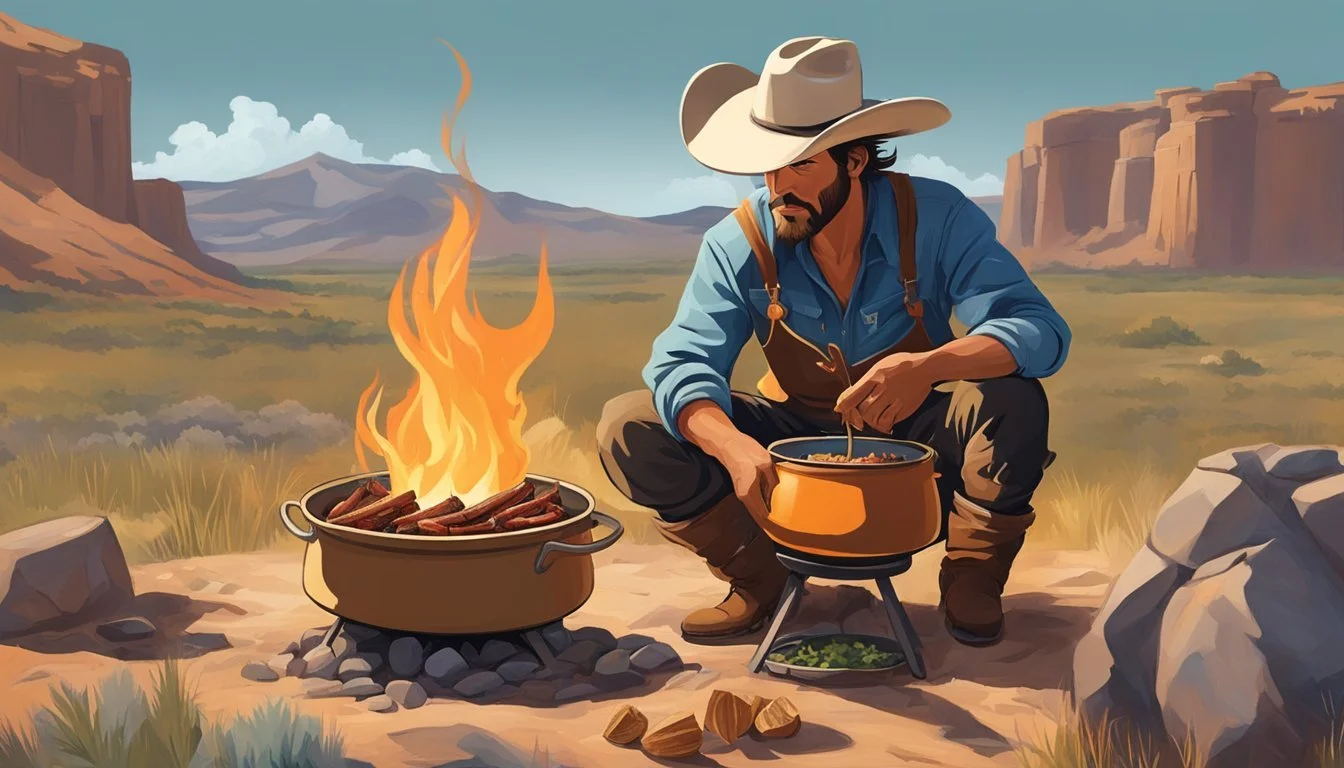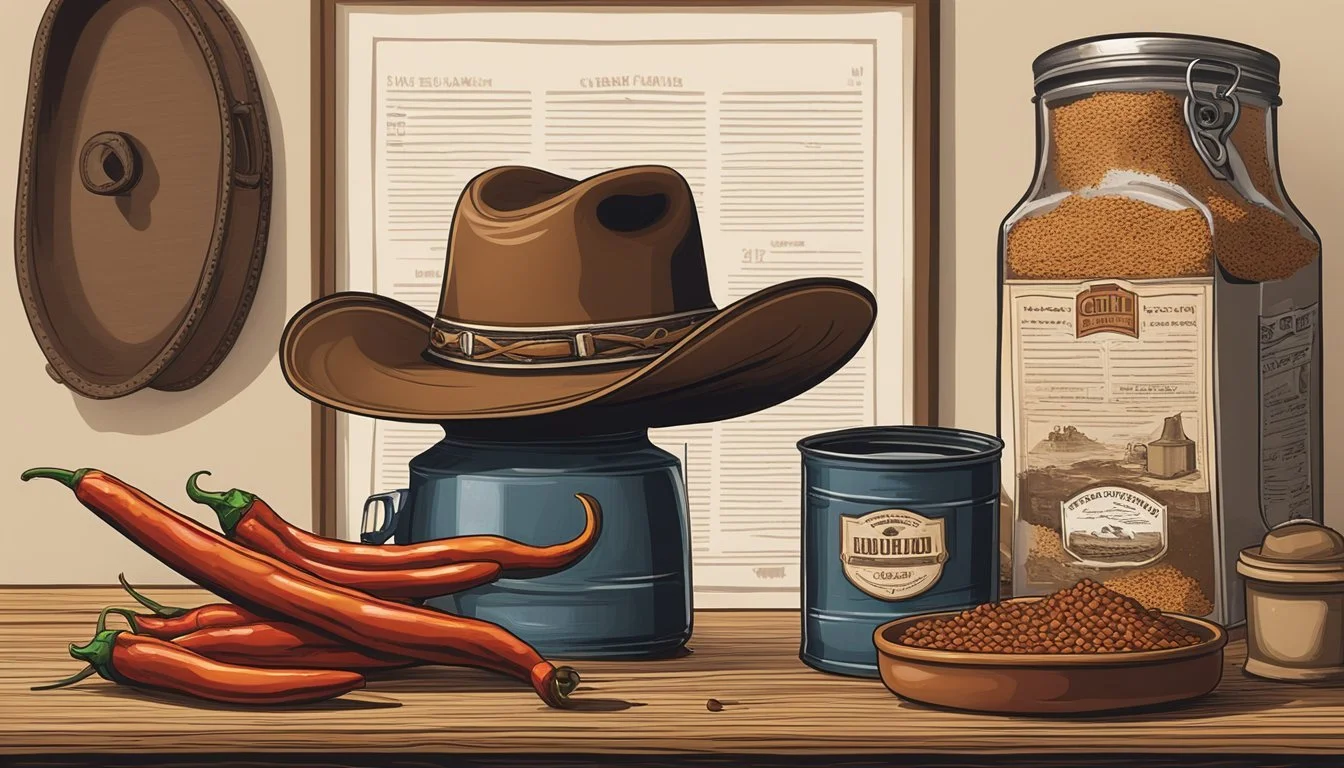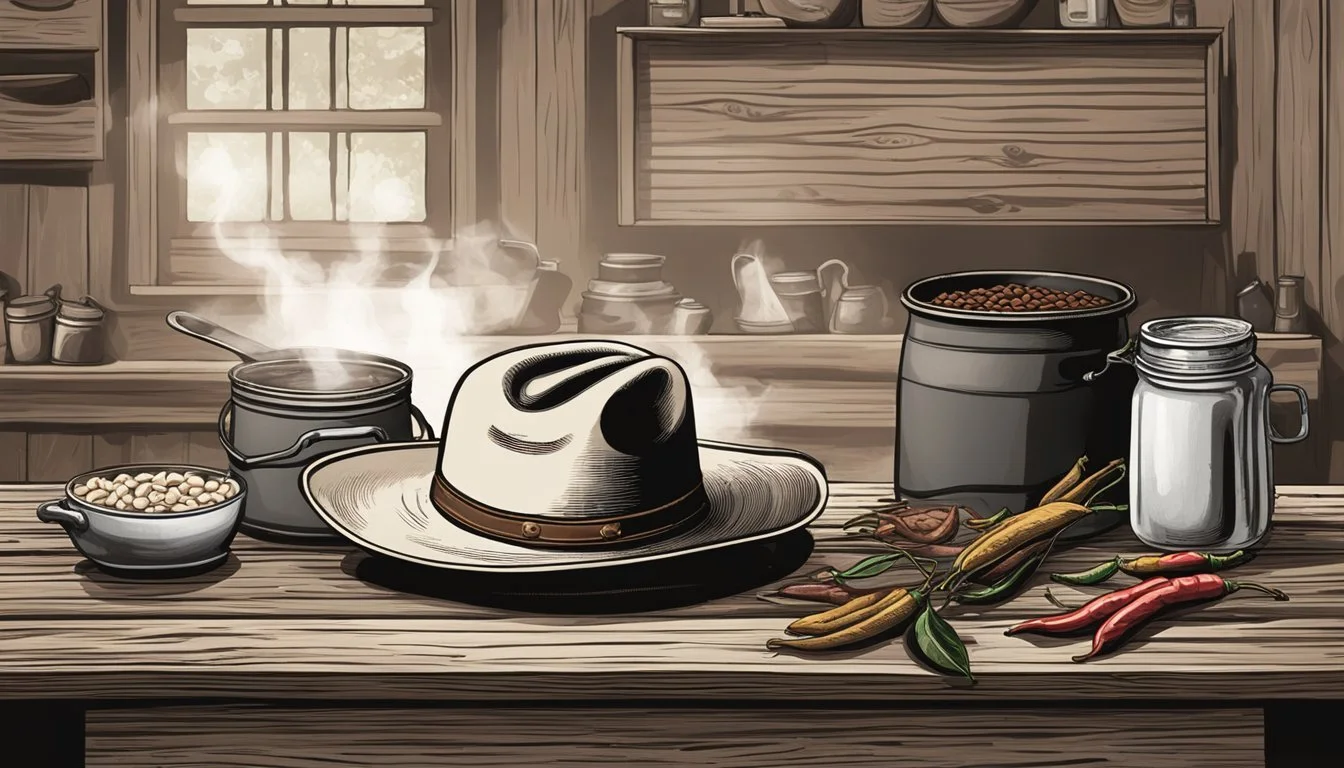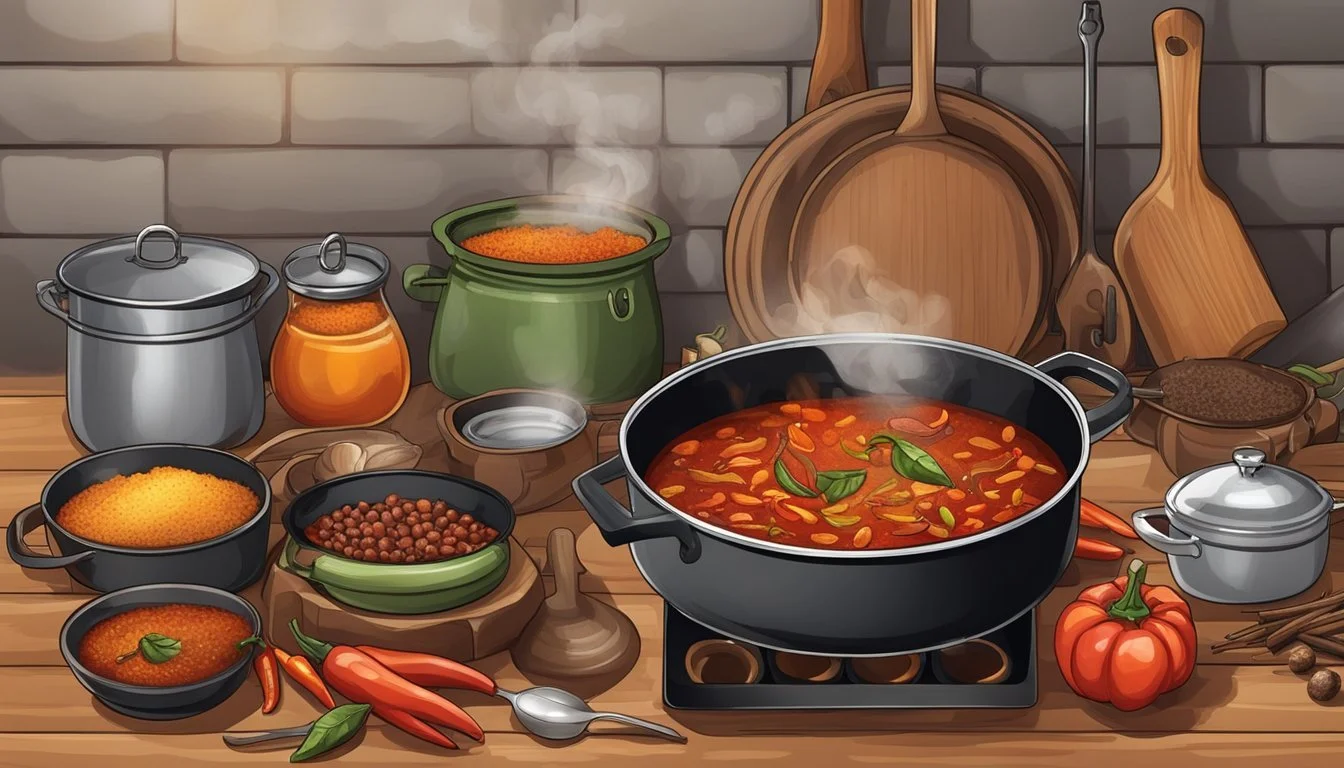The Art of Making Chili
Mastering a Cowboy Classic
The tradition of cowboy chili has its roots deeply embedded in the heritage of the American West, an icon of cowboy culture and an enduring emblem of frontier cuisine. Made popular by cattle drive cookhouses, this robust dish provided sustenance and comfort to cowboys after a long day herding cattle across vast expanses. Chili’s hearty nature made it an ideal meal, offering much needed protein and calories, presented in a form that could be easily cooked over an open flame in cast iron cookware or Dutch ovens.
Cowboy food needed to be both practical and portable. Ingredients for cowboy chili consisted of readily available staples such as beef—the centerpiece of any cattle drive—as well as beans and spices that could survive the journey in a chuckwagon. Over time, these core components have evolved into recipes brimming with regional flavors and personal touches, yet the essence of the dish remains unchanged: a warm, spicy stew that symbolizes the resilience and spirit of the cowboys themselves.
As chili made its transition from campfires to cook-offs, its preparation has been honed into an art, combining flavors and techniques to create a meal that is both a nod to the past and a testament to culinary creativity. Every bowl holds a story, a blend of simplicity and complexity that exemplifies the very notion of comfort food in American history.
Historical Context
In tracing the evolution of chili, one discovers a dish deeply embedded in American history, particularly in Texas, where it became a symbol of cowboy culture.
Origins of Chili
The earliest documented reference to chili dates back to an 1828 journal by J. C. Clopper, who described it as a stew-like dish prevalent in San Antonio, Texas. Historical accounts suggest that chili's roots may lie in a simple, spicy hash prepared by working-class Tejanos.
Evolution into Cowboy Staple
As pioneers traveled westwards, portability and ease of preparation made chili an ideal dish for cowboys. Dried beef, chili peppers, and other spices could be easily packed and cooked over campfires, leading to its adoption as a staple among cowboys in the Old West.
Texas Cowboy Chili as an Emblem
In the Lone Star State, chili evolved into a proud symbol of tradition—Texas cowboy chili. It displayed the resourcefulness of cowboys who operated under rugged conditions, turning basic ingredients into a hearty meal. The dish's fame was solidified when chili cook-offs became popular in the mid-20th century, celebrating the heritage and skill involved in crafting the perfect bowl of red.
Fundamentals of Chili Making
The essence of crafting a classic chili lies in the thoughtful selection of ingredients, skillful meat preparation, and the fine art of balancing flavors to achieve a robust and satisfying dish.
Selecting Ingredients
A foundational chili recipe begins with quality ingredients. Key components typically include meat (beef is a popular choice), tomatoes, and beans for substance.
Meat: Beef, often ground or cut into cubes, serves as the protein base.
Tomatoes: Fresh or canned, they add acidity and body.
Beans: Kidney or pinto beans provide texture and are a traditional element, though some chili purists may choose to omit them.
Herbs and spices are crucial for depth and interest, with cumin, chili powder, and oregano being common. Freshness and quality of spices directly impact the chili's flavor profile.
Preparing the Meat
Meat preparation is central to chili's hearty texture. Browning the meat is a critical step, as it adds a dimension of flavor through caramelization. For a typical chili, one might brown:
2 pounds of ground beef (or a mix with wild game or chunk meat) until it loses its pinkness.
The meat should be drained of excess fat before other ingredients are introduced to ensure a rich but not overly greasy final product.
Balancing Flavors
Achieving the perfect chili flavor is a delicate balancing act:
Salt and Pepper: Essential for enhancing all the other ingredients.
Spices: Adjust the chili powder, cumin, and pepper according to taste, starting with modest amounts and building up.
Acidity: A balance between the tomatoes and added elements like a splash of vinegar can counteract richness and add brightness.
As the chili simmers, these flavors meld, and one should taste and adjust the seasoning periodically to achieve the desired flavor profile. Consistent tasting and tweaking allow for a well-rounded and palatable dish.
Cowboy Chili Ingredients
The elements that go into making Cowboy Chili are distinguished by their robustness and simplicity. Authentic Cowboy Chili relies on a balance of hearty meats, a variety of beans, and a mix of vegetables and spices that offer both flavor and texture.
Meats: From Beef to Bison
Beef is traditionally the cornerstone protein in Cowboy Chili, with 2 pounds being the standard amount for a generous batch. The beef is typically ground or cut into small chunks to ensure even cooking and distribution throughout the dish. For a gamey twist, bison (What wine goes well with bison?) is an excellent substitute, offering a leaner alternative but with a similar depth of flavor.
Beans and Their Preparations
Chili would not be complete without its staple legumes. Pinto beans, kidney beans, and black beans are the most commonly used types. They're often prepared from a dry state, soaked overnight, and then cooked until tender to provide a creamy texture against the hearty backdrop of the meats. A standard chili might include:
1 can pinto beans, drained
1 can kidney beans, drained
1 can black beans, drained
Vegetables and Spices
A mirepoix of chopped onion and minced garlic forms the aromatic base for Cowboy Chili. Tomatoes enter the composition as both freshly chopped and tomato sauce, providing acidity and body. The spices — chili powder, cumin, oregano, paprika, and a dash of cayenne — are essential for that characteristic warm heat and complexity. The precise measure of spices may look like:
2 tablespoons chili powder
1 tablespoon cumin
1 teaspoon oregano
1 teaspoon paprika
1/4 teaspoon cayenne (or to taste)
Additional veggies such as bell peppers or corn are sometimes introduced, contributing sweetness and texture to the chili.
Cooking Techniques
In the realm of chili preparation, specific techniques are paramount to achieving the quintessential heartiness and flavor of a cowboy staple. Utilizing the right equipment, such as a Dutch oven, and mastering the methods of simmering and sautéing can elevate chili to its peak potential.
Using a Dutch Oven
A Dutch oven is the ideal vessel for making cowboy chili due to its heavy construction and ability to retain heat evenly. Cooks often prefer it for its versatility, as it can transition from stovetop sautéing to oven-baked simmering without changing pots. When using a Dutch oven, the cook starts by heating it over the fire or stove; once hot, ingredients can be added in stages. Initially, meats are browned to develop depth of flavor.
Simmering to Perfection
The art of simmering plays a crucial role in the development of chili's complex flavors. Once all ingredients are combined in the Dutch oven, the chili should be brought to a boil and then reduced to a simmer. This low and slow-cooked approach allows for flavors to meld over time, often stretching over several hours of cooking time to reach optimal richness.
Browning Meat and Sautéing Vegetables
To build a robust base, browning the meat is a fundamental step. This should be done in small batches to ensure each piece caramelizes properly. Following the browning, onions and garlic are typically sautéed until translucent, setting the stage for the aromatic backdrop of the dish. It's during this phase that spices like chili powder and cumin are added to infuse the meat with iconic chili flavors.
Chili Recipe Variations
In the diverse world of chili, each variant is a testament to regional flavors and personal taste preferences. One can encounter a wide array of meats and spices and discover countless adaptations suitable for different diets and palates.
Regional Takes on Cowboy Chili
Different regions put their own unique spin on cowboy chili, primarily distinguished by the meat choices and spice combinations. Texas-style chili, often referred to as Texas Red, typically omits beans and uses chunks of beef rather than ground meat. Individuals seeking the authentic taste of the Southwest might favor chilies such as New Mexico Chili Verde, which relies on green chilies and pork.
In contrast, Colorado cowboy chili often has a heartier feel, incorporating a blend of meats, including beef and sometimes bison, creating a rich, complex flavor profile. It's common to find Colorado chili enthusiasts adding a touch of sweetness to the mix with ingredients like honey or dark chocolate.
Alternative Proteins and Vegetarian Options
While traditional cowboy chili is meat-heavy, there are variations that cater to those looking for alternative proteins or vegetarian options. Here are some popular protein alternatives:
Bison: Leaner than beef with a rich, slightly sweet flavor.
Venison (What wine goes well with venison?): Common in rural areas, offering a gamey taste.
Ground Turkey: A lighter option that absorbs the chili spices well.
For a vegetarian take, one could swap meat with hearty vegetables like sweet potatoes or varied beans, which provide ample protein and texture. Some recipes even use quinoa to maintain the chili's traditional heft.
Creative Toppings and Sides
Chili lovers often argue that the dish is as much about the toppings as it is about the stew itself. The right combination can elevate a simple bowl of chili to new culinary heights. Here's a table showcasing popular toppings:
Toppings Description Sour Cream Adds a creamy, cooling contrast. Cheese Melty cheese contributes richness. Cilantro Offers a fresh, herby burst. Onions Raw or sautéed for an extra crunch.
When it comes to sides, a slab of cornbread or a handful of tortilla chips provides a crunchy counterpoint to the chili's savory, spicy depth. Additionally, sides like rice or a simple green salad can balance out the meal.
Pairings and Accompaniments
When crafting a traditional cowboy chili, selecting the appropriate pairings and accompaniments is essential. Complementary sides can enhance the main dish's flavors and offer a variety in texture and taste.
Cornbread and Biscuits
Cornbread is a classic companion to chili. Its slightly sweet flavor and crumbly texture make it an ideal counterpart to the rich and spicy chili. Its simplicity in baking, often requiring just cornmeal, flour, baking soda, eggs, and buttermilk, allows it to be easily prepared alongside the main dish.
Biscuits, another robust option, bring a buttery and soft alternative to the table. They can be used to soak up the hearty sauce of the chili, ensuring that none of the flavorful broth goes to waste. Both cornbread and biscuits serve not only as a delicious addition but also as a means to sate heartier appetites.
Side Dishes to Enhance Chili
In the realm of side dishes, certain selections are known to balance and highlight the central flavors of cowboy chili.
Green Bell Pepper: Sautéed green bell peppers add a bright, slightly sweet contrast to the deep, smoky flavors of the chili.
Potatoes: Roasted or mashed, potatoes are a filling and neutral side that can absorb the chili's complexities.
Mushrooms: Earthy mushrooms, when sautéed, can add umami—a savory taste that pairs exceptionally well with the meatiness of chili.
Additionally, serving chili with a cold beer can cleanse the palate between bites, allowing each mouthful to be as impactful as the first. The effervescence of the beer offers a refreshing break from the heartiness of the chili.
Selections of sides like these not only support but elevate the experience of enjoying a bowl of homemade cowboy chili.
Cookware and Tools
The right cookware can significantly affect the flavor and texture of chili, a dish where slow cooking and even heat are paramount. Selecting the appropriate tools is a crucial step in crafting an authentic cowboy chili.
Cast Iron Cookware
Cast iron cookware is the traditional choice for making cowboy chili. The cast iron skillet and dutch oven both offer superior heat retention and distribution which is essential for evenly browning meat—a foundational step in chili preparation.
Cast Iron Skillet: Ideal for the initial browning of the meat, usually beef, over medium-high heat.
Dutch Oven: Perfect for simmering chili at a consistent temperature, allowing flavors to meld together over an extended period.
Slow Cookers & Other Equipment
For an effortless cooking process, a slow cooker allows chili to be left to cook on its own, without the need for constant supervision. The slow cooker ensures that the chili cooks at a controlled temperature and helps in tenderizing tougher cuts of meat over time.
Slow Cooker: Convenient for unattended cooking, it guarantees a hearty and evenly cooked meal.
Other Equipment: While not as traditional, modern electric pressure cookers can also be utilized to hasten the cooking process while still maintaining a tender, flavorful result.
Serving and Storage
Successful serving and storage of chili can greatly enhance its flavors and longevity. Attentive plating and presentation transform chili into a feast for the eyes, while proper storing and reheating practices ensure that the robust flavors of this comfort food are preserved.
Plating and Presentation
When serving chili, one should consider both aesthetics and guest preferences. A common practice is to ladle the rich, hearty chili into a bowl, ensuring an even distribution of meat, beans, and vegetables. Toppings such as shredded cheese, diced onions, or sour cream can be offered on the side, allowing guests to customize their dish. For an added crunch and texture, a handful of corn chips can be either sprinkled on top or served alongside. A sprig of cilantro can also be used to garnish the dish, adding a fresh, aromatic finish.
Storing and Reheating
Chili's flavors often deepen with time, making it an excellent dish for storage and reheating. Cool the chili to room temperature before storing it to maintain food safety. It can then be transferred into airtight containers and refrigerated for up to three days or frozen for longer storage. To reheat, one should thaw the chili, if frozen, and then warm it on the stove over medium heat until it reaches a simmer; this ensures even heating without scorching. For those in a rush, microwaving the chili in a covered microwave-safe dish is a quick alternative. Reheating should be done until the chili is steaming hot, which not only improves its taste but also assures that it is safe to eat.
Creating a Hearty Cowboy Chili
A hearty cowboy chili is the epitome of comfort food: nourishing and bursting with flavor. This robust dish traditionally centers around ground beef or beef cubes, cooked to perfection, offering a deeply satisfying experience. The preparatory steps are paramount to achieving the rich taste that characterizes cowboy chili.
Ingredients:
Beef (Ground or Cubed)
Onions
Garlic
Chili Powder
Cumin
Diced Tomatoes
Beef Broth
Optional: Beans
Seasonings: Oregano, Cayenne Pepper, Salt, Black Pepper
Initial Steps:
Begin by browning the beef in a large fry pan or heavy bottomed soup pot. This should take about 10 minutes for ground beef or 2-3 minutes per side for cubes.
Add in onions and garlic, sautéing until the onions are softened.
Seasoning:
Stir in spices such as chili powder and cumin. The quantities can be adjusted according to preference for heat and flavor.
For added depth, oregano and a pinch of cayenne pepper elevate the taste profile.
Simmering:
Introduce diced tomatoes and broth to the pot, stirring to combine.
Lower the heat, cover, and allow the chili to simmer. This low and slow cooking melds the flavors and tenderizes the beef.
Cook Time:
The cook time varies; however, a low heat simmer for at least an hour is recommended to develop a complex flavor profile.
When served, this nourishing and hearty cowboy chili not only warms the body but also offers a welcoming burst of traditional flavors. It's a dish made with confidence, reflecting the rugged simplicity and richness of the cowboy lifestyle.
Advanced Tips and Tricks
Mastering the art of chili requires an understanding of how to attain the ideal consistency and balance of flavors. Experts often employ a range of sophisticated techniques to elevate their chili beyond the everyday bowl.
Thickening Techniques
Chili aficionados often seek a rich, thick consistency. One effective method is to incorporate masa harina, a traditional Mexican flour that simultaneously thickens and imparts a slight corn flavor. A slurry made from masa harina and water can be stirred into the chili, allowing it to simmer and thicken.
Masa Harina Slurry: For each cup of chili, mix 1 tablespoon of masa harina with 2 tablespoons of water, and add to the chili during the last 20 minutes of cooking.
Another option is the use of chile powder or ground chiles, which can absorb excess liquid while also enhancing the flavor profile.
Chile Powder Addition: Gradually sprinkle and stir in chile powder during cooking to achieve desired thickness and intensity.
Layering Flavors
Building a complex flavor profile in chili involves the careful addition of ingredients at strategic points during the cooking process. Starting with bacon, render the fat and use it as the base to sauté onions and minced garlic this infuses the dish with a smoky undertone.
Sauté Sequence: Render bacon → Remove bacon → Sauté onions and garlic in bacon fat.
Seasoning mixes should be added to the meat as it browns, making sure to toast the spices slightly to unlock their aromas. Introduce ancho or adobo sauce early on to lay a foundation for a smoky depth, but reserve some spices to adjust flavors closer to the end.
Spice Timing: Brown meat with initial spices → Add ancho/adobo → Adjust with additional spices before serving.
Incorporating Unique Ingredients
For a unique twist, chefs may add unconventional ingredients such as coffee, which can impart a robust, earthy note to the dish.
Coffee Enhancement: Add 1/4 cup of strong brewed coffee for every 2 quarts of chili to deepen flavor complexity.
Uncommon yet flavorful choices like artisanal chile powder or homemade seasoning mixes are other avenues to explore. These can replace standard grocery store options for a more memorable chili experience.
Artisanal Choices: Replace generic chile powder with single-origin chile powders for nuanced flavors.








